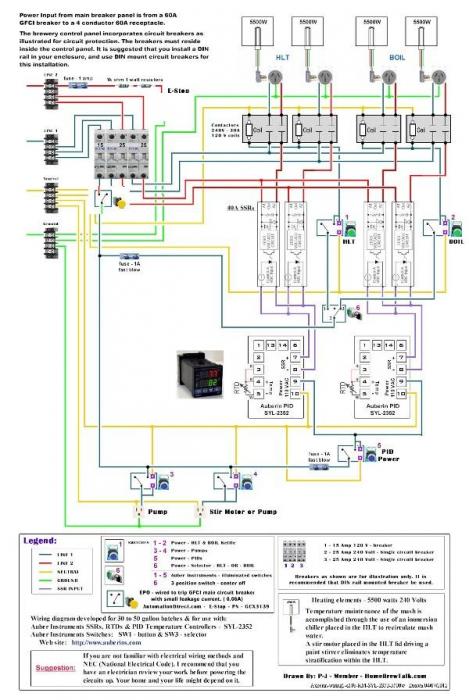Rad-Rabbit
Well-Known Member
Hi All,
I'm interested in constructing a control panel capable of 93gal-108.5gal (3bbl-3.5bbls). It needs to function on single phase 240v and be capable of running at least 4 (5500w-6000w) elements at a time. I would prefer to be able to run all 8 for back to back batches but even 3+3 would likely suffice for that propose. Yes, this is for a "would be" nano in a non-industrial area which is why I'm not talking 3 phase 240v or 480v.
I've done quite a bit of research and it seems that 60A (actually, I think I've come across an 80A but at this point that doesn't really help) is the likely the largest standard GFCI available. I'm fairly certain that NEC doesn't allow 4 separate supply feeds to enter the single control panel, but if it did, shouldn't it be (Please correct me if I'm wrong) as simple as adding 1 more 60A GFCI supply feed and additional (DIN breaker, contactor, SSR, ect) to the P-J drawings below to run 4 elements? Or removing the selector and adding 3 more 60A GFCI Supply feeds plus the additional (DIN breakers, contactors, SSRs, etc) to run all 8 elements? The E-Stop would function identical to the below schematic by adding 1-3 (depending on setup) add on NO Contacts to the original E-Stop to trip the additional GFCI's. Again, please correct me if I'm wrong.
Obviously life would be life would be simple if I could just build what I propose above but I just don't think that would function up to code. UNLESS, I installed 4-60A receptacles in the brew-house and the control panel wasn't hard wired, then the inspector wouldn't have to look into my control panel, but I digress.
How do I put this sucker together from a single HARD WIRED feed and do it safely? or do I just do the above proposal? I've been researching and I'm at a loss.
BTW- P-J, if you're reading this post, I'd like to thank you for all the help you provided in these forums. I have followed your posts for years, you are truly a great service to this community. Your drawings have been an inspiration to me and this project from the start.

I'm interested in constructing a control panel capable of 93gal-108.5gal (3bbl-3.5bbls). It needs to function on single phase 240v and be capable of running at least 4 (5500w-6000w) elements at a time. I would prefer to be able to run all 8 for back to back batches but even 3+3 would likely suffice for that propose. Yes, this is for a "would be" nano in a non-industrial area which is why I'm not talking 3 phase 240v or 480v.
I've done quite a bit of research and it seems that 60A (actually, I think I've come across an 80A but at this point that doesn't really help) is the likely the largest standard GFCI available. I'm fairly certain that NEC doesn't allow 4 separate supply feeds to enter the single control panel, but if it did, shouldn't it be (Please correct me if I'm wrong) as simple as adding 1 more 60A GFCI supply feed and additional (DIN breaker, contactor, SSR, ect) to the P-J drawings below to run 4 elements? Or removing the selector and adding 3 more 60A GFCI Supply feeds plus the additional (DIN breakers, contactors, SSRs, etc) to run all 8 elements? The E-Stop would function identical to the below schematic by adding 1-3 (depending on setup) add on NO Contacts to the original E-Stop to trip the additional GFCI's. Again, please correct me if I'm wrong.
Obviously life would be life would be simple if I could just build what I propose above but I just don't think that would function up to code. UNLESS, I installed 4-60A receptacles in the brew-house and the control panel wasn't hard wired, then the inspector wouldn't have to look into my control panel, but I digress.
How do I put this sucker together from a single HARD WIRED feed and do it safely? or do I just do the above proposal? I've been researching and I'm at a loss.
BTW- P-J, if you're reading this post, I'd like to thank you for all the help you provided in these forums. I have followed your posts for years, you are truly a great service to this community. Your drawings have been an inspiration to me and this project from the start.







